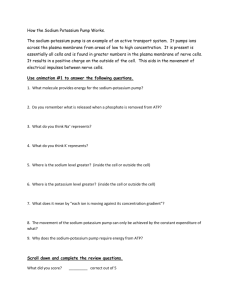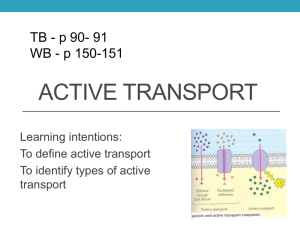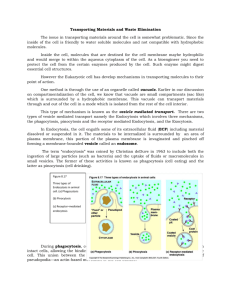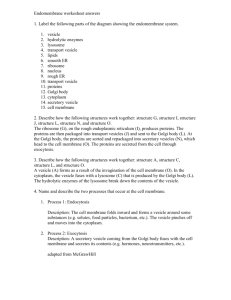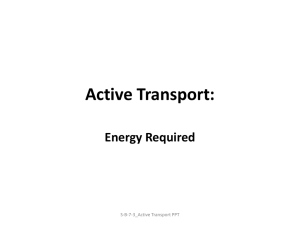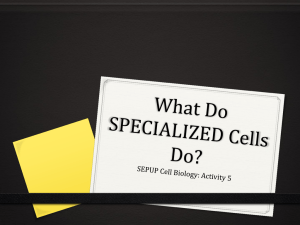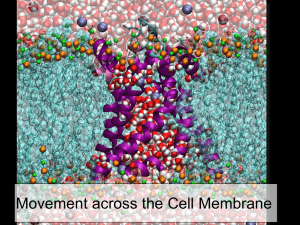Active Transport
advertisement
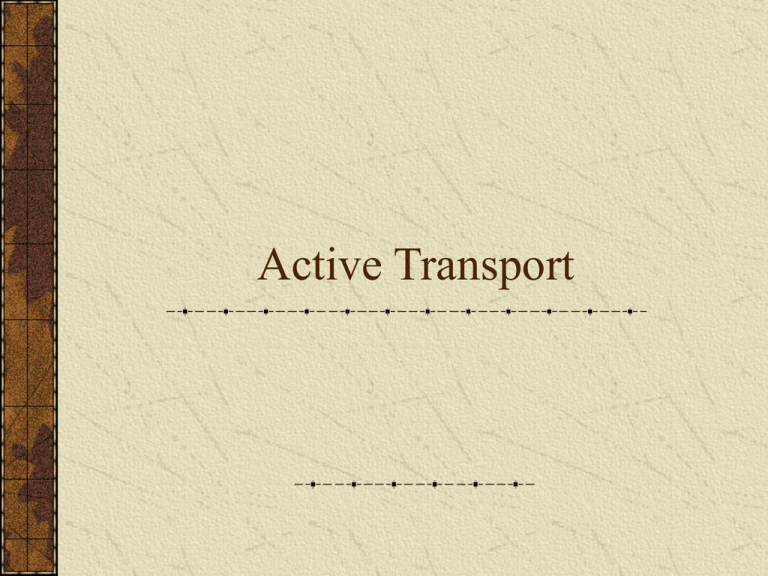
Active Transport Active Transport Cellular energy is used to to transport substances across the membrane against a concentration gradient Energy is derived from splitting ATP Pumps A transporter protein that uses energy from splitting ATP to change shape and carry a substance across a cellular membrane against its concentration gradient Substances Transported Na+ K+ H+ Ca++ ICl- Sodium-Potassium Pump Expels Na+ from the cell, brings K+ into the cell Acts as an enzyme to split ATP Used to maintain a low [Na+] concentration in the cytosol by pumping Na+ into the extracellular fluid Continuous Operation Na+ and K+ slowly leak back across the membrane down their gradients, so the pumps must continuously move these ions back across the membrane to maintain the concentration gradient. Concentration Gradient The differing concentrations are crucial for osmotic balance of the 2 fluids and also for the ability of some cells to generate electrical signals Operation of the Sodium Potassium Pump 1. Three Na+ in the cytosol bind to the pump protein 2. Na+ binding triggers the splitting of ATP into ADP plus a phosphate group which attaches to the pump protein. This causes a change in the shape of the pump protein 3. Three Na+ are expelled into the extracellular fluid Operation of the Sodium Potassium Pump 4. The changed shape allows 2 K+ in the extracellular fluid to bind to the protein 5. The binding of the K+ causes the phosphate group to be released which causes the pump protein to return to its original shape 6. As the pump protein returns to its original shape, it releases the 2 K+ into the cytosol. The pump protein is then ready to bind Na+ and the cycle can repeat Malfunctions of Transporters Drugs – some turn off ATP production which would stop active transport of substances throughout the body Cystic Fibrosis – a defective gene causes an abnormal Cl- transporter. There is a failure to secrete adequate amounts of Cl- resulting in extremely thick mucus secretions that result in obstruction and infection. Transport in Vesicles Vesicle – a small sac formed by the budding off from an existing membrane Movement of vesicles requires energy supplied by ATP. ENDOCYTOSIS Materials move into a cell is a vesicle formed from the plasma membrane Phagocytosis Bulk Phase Endocytosis Phagocytosis Large solid particles (like whole cells) are taken in by the cell. The particle binds to the plasma membrane receptor, the cell extends projections called pseudopods that surround the particle, then the membranes fuse to create a vesicle in the cytoplasm. Any undigested material remain indefinitely in a vesicle called a residual body Phagocytosis occurs only in special cells called phagocytes They are specialized cells used to engulf and destroy bacterial and other foreign substances • These cells include certain white blood cells and macrophages. • Phagocytosis is one of the body’s defense mechanisms against disease Bulk Phase Endocytosis Cells take up vesicles containing tiny droplets of extracellular fluid and any solutes dissolved in that fluid The vesicle detaches from the membrane and enters the cytosol The vesicle fuses with a lysosome where enzymes digest the solutes into smaller molecules Exocytosis Results in secretion – materials exiting the cell Secretory cells give off digestive enzymes, hormones, mucus or other secretions Nerve cells give off neurotransmitters Secretory Vesicle Vesicle containing substance to be secreted forms in the cytosol, fuses with the plasma membrane then releases the contents into the extracellular fluid CHECKPOINT What is the key difference between active and passive transport? Briefly compare/contrast facilitated diffusion and active transport through a membrane pump Describe the process of phagocytosis. Name one way phagocytosis helps to maintain homeostasis.

